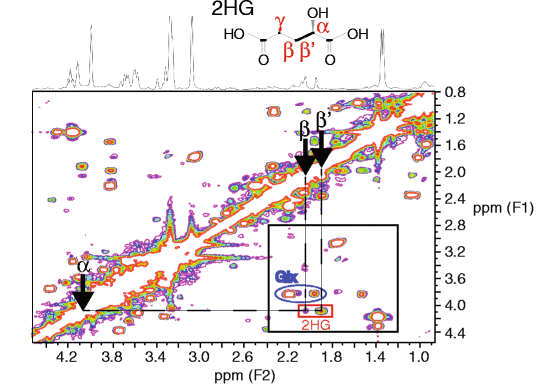Researchers at Winship Cancer Institute have developed a technique for detecting an "oncometabolite," a chemical produced by some brain tumors’ warped metabolism, via non-invasive imaging.
Their approach could allow doctors to know not only that a brain tumor is there, but also that it carries a particular genetic mutation. The researchers’ technique uses magnetic resonance spectroscopy (MRS) to measure a chemical, 2-hydroxyglutarate, that is scarce in normal tissues. 2-hydroxyglutarate is produced by some types of brain tumors carrying mutations in an enzyme called isocitrate dehydrogenase (IDH).
The results were published this week by the Journal of Molecular Medicine.
The research was a collaboration between the laboratories of Hui Mao, PhD, associate professor of radiology and imaging sciences and Emory University Center for Systems Imaging, and Erwin Van Meir, PhD, professor of neurosurgery and hematology and medical oncology. The first author of the paper is postdoctoral fellow Juliya Kalinina. Emory undergraduate Anne Carroll also contributed to the project.
The Emory team is one of several research groups who have obtained similar results recently.
"This is a significant advance, in that we can have a glimpse into the human brain without actually having to do brain surgery," Van Meir says. "The technique offers the possibility of following the patient after surgery to see if the treatment is working, by monitoring the decline in levels of the oncometabolite."
"This technique shows great potential for profiling a brain tumor based on its genetic and metabolic finger-prints," Mao says. "It may be possible to repeatedly and non-invasively monitor tumor progression, helping physicians to make decisions about the direction and timing of treatment."
Mutations in the genes IDH1 or IDH2 cause a distortion of cells’ metabolic cycles and the accumulation of 2-hydroxyglutarate. The presence of the mutations means patients generally survive longer, but they don’t respond as well to standard radiation and chemotherapy treatments.
Mutations in IDH1 or IDH2 are found in roughly 70 percent of low- and intermediate-grade gliomas, but usually not in primary forms of a more aggressive form of brain cancer, glioblastoma. Secondary glioblastomas that come from lower-grade gliomas do have the mutations.
To verify the test as a diagnostic tool, DNA from 65 glioma patients’ biopsy samples was analyzed; 39 had mutations in IDH1 or IDH2. Magnetic resonance spectroscopic analysis of the samples could predict the presence of the mutation with 98 percent accuracy.
The technique uses magnetic resonance imaging equipment that is already widely used in hospitals for diagnostic imaging , but modifies the detection method in order to detect 2-hydroxyglutarate. No injections or special equipment would be needed for clinical use, Mao says.
"We wanted to establish the feasibility of detecting 2HG using FDA-approved scanners that are currently available in the clinic, over a time period that is tolerable to the patient – in about 20 or 30 minutes," he says.
MRS has been used to monitor therapeutic progress for brain cancer patients. In contrast with the new technique, established methods measure chemicals that are present in healthy tissues and cannot distinguish 2HG from the other chemicals in the brain.
Recent research indicates that 2-hydroxyglutarate accumulation leads to the activation of genes that are usually shut off in healthy cells. Several laboratories are looking for ways to reverse the metabolic changes in the IDH1/2-mutated cells as a form of targeted therapy.
The research was supported by the National Cancer Institute, the Atlanta Clinical and Translational Science Institute, the Georgia Cancer Coalition, and the Brain Tumor Funders Collaborative.
Reference:
J. Kalinina, A. Carroll, L. Wang, Q. Yu, D.E. Mancheno, S. Wu, F. Liu, J. Ahn, M. He, H. Mao and E.G. Van Meir. Detection of "oncometabolite" 2-hydroxyglutarate by magnetic resonance analysis as a biomarker of IDH1/2 mutations in glioma. J. Mol. Med. online first (2012).

